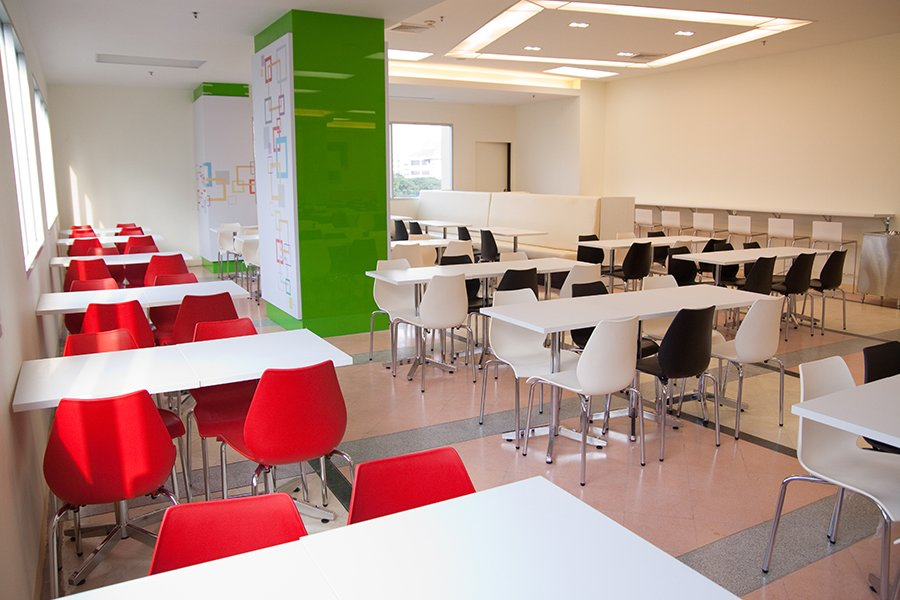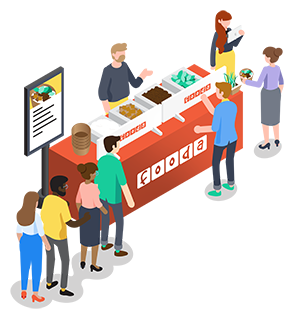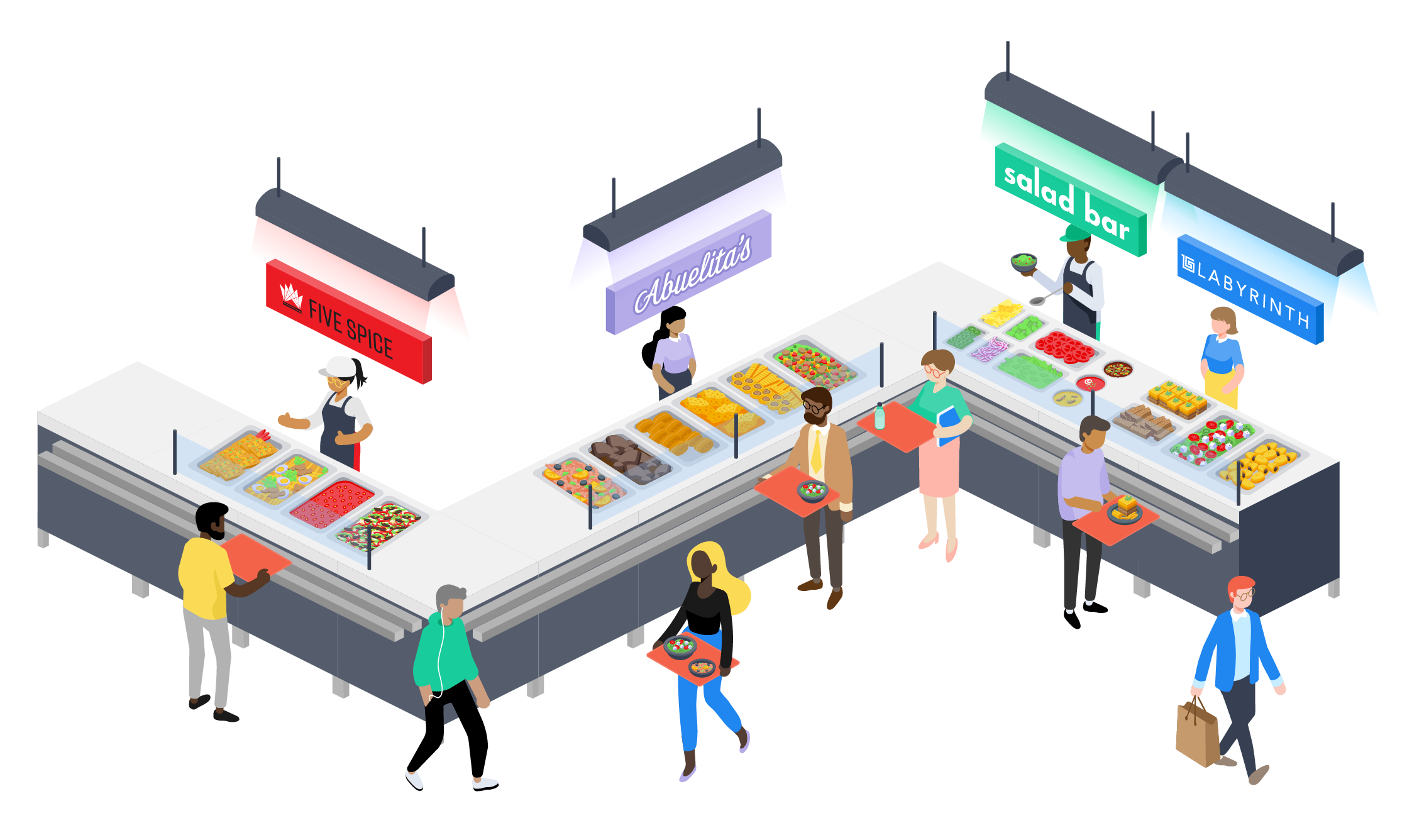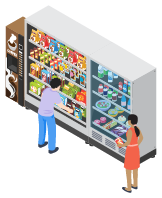
If you’re starting to reevaluate the dining options for your company, you’re likely considering traditional corporate cafeteria management companies. But do you really know what happens behind the scenes and are they still the best choice for meeting company and employee expectations?
We’ll start with the basics and explore how they work and operate, then we’ll dig into the details and learn why modern alternatives are taking over the workplace food service industry.
A corporate cafeteria is an on-site dining facility where employees can purchase meals (usually lunch) without leaving the workplace. Each meal might be paid for by the company, by the employee, or a combination of the two.
Office cafeterias can also serve entire buildings containing multiple businesses, making them a shared amenity across organizations. Some companies run their cafeterias completely in-house (self operated), but many find it more economical to partner with a management company that handles everything from procurement to daily operations.
You'll often hear "corporate cafeteria, "office cafeteria," and "company cafeteria," used interchangeably. But these three terms typically refer to the same concept: an employer-provided dining space.
The key point is that regardless of terminology, these spaces share common operating practices and challenges… which we’ll look at now.
To put it simply, corporate cafeteria management companies handle everything related to your dining operation. They order food, plan menus, prepare meals daily, and manage cleanup. Many also assist with initial setup and design if you don't have an existing cafeteria.
Let’s take a look at each step in a bit more detail:

Just like most businesses, corporate cafeteria companies try to generate revenue through multiple streams:
However, in the current market, the conventional cafeteria model faces margin pressure. Employers are challenging the traditional models and looking to alternative solutions (like Popup or delivery) as prices go up and quality goes down, leading to dwindling cafeteria participation.
Figuring out exactly how much you’ll pay can be difficult. Each vendor will deliver a custom quote for your in-house cafeteria. But you can bet that the management fees will add up to a lot.
For example, a limited or capped subsidy system sees your company paying the management organization a specific amount each month or year. If the management company goes over that amount, they’re liable for the cost.
In contrast, with a full subsidy, your company pays for everything the cafeteria provider needs. This is a tough place to be in, as the management company has little incentive to reduce their overhead costs while they continually benefit from kickbacks.
Understanding the financials should help you evaluate what’s possible for your company. Here’s what the cost of a standard corporate cafeteria management company might look like (and that’s if you already have the infrastructure):
That’s a lot of money to be spending on food for your employees when there can still be issues at the end of the day… It's one of the main reasons we’re seeing companies switch to more modern and affordable workplace food service models.
Despite their convenience, traditional corporate cafeterias still face three major challenges that impact their effectiveness and employee satisfaction. This makes them hard to justify in today’s world.

Not only that, but each chef (no matter how talented) has a specialty. Maybe it’s French food, or American cuisine, or they could have trained in Mexico. Sure, all chefs have a variety of influences and dishes from other parts of the world, but they can’t drastically change their style from week to week on a limited supply and budget.
Both of these things mean that employees get the same meals regularly. It might not be every week, but even with a cycle of three or four weeks, people can get bored. That’s called menu fatigue.
Modern employees demand authentic dining experiences. They want meals prepared by chefs with genuine cultural expertise. Depending on your corporate cafeteria management company, you may end up with a chef who has authentic South American or Asian experience… or you might not.
Additionally, today's workforce values supporting local businesses and sustainability. They prefer ingredients sourced locally and packaging that's environmentally responsible. Old-fashioned cafeterias, built on relationships with massive national distributors, struggle to meet these expectations without significantly impacting margins.
If you have a company cafeteria, you want your employees to take advantage of it as much as possible. If they’re not using the cafeteria, the economics of the situation quickly get out of hand.
But because of the problems mentioned above, employees just aren’t using corporate cafeterias as much as they used to. That forces corporate dining services to raise prices or further cut costs, leading to even less participation.
Beyond the financial aspect of decreasing participation, it makes it hard to justify providing this perk to your employees. If they’re not taking advantage of it (and not enjoying it) is it worth the time, effort, and money it takes for you to provide it?
Okay, so it’s clear that traditional corporate cafeterias have some problems. Fortunately, the future of workplace dining is being shaped by companies that recognize the limitations of traditional cafeteria management.
Rather than locking companies into traditional single-vendor relationships, Fooda offers options that adapt to your organization's needs. Our solutions include:

This solves the menu fatigue and expensive overhead issues by bringing authentic local restaurants into your workplace on a rotating basis and leveraging their employees. With this, your team gets to discover new restaurants and experience a variety that a single vendor simply cannot provide.
Food halls like the one at Hyatt headquarters exemplify this model: rotating local restaurants alongside signature chefs gives employees both reliable quality and exciting options. With Fooda Popups, you get this same variety without building an entire (expensive) food hall infrastructure.

For organizations that need the reliability of traditional cafeteria management but want to avoid the common problems, Fooda's cafeteria solutions incorporate our Popup principles while still offering consistent options for those that love their routine.
Think about your current everyday sandwich deli or salad bar but with additional rotating options. You get the infrastructure of an in-house cafeteria without the large overhead.

Getting lunch delivered to the office can be a headache with inconsistent drivers not knowing where to go, showing up late, and limited ordering options (both volume and type of restaurants).
Fooda lunch delivery eliminates the struggles of using major delivery services by providing your teams with individual, consolidating ordering from a list of rotating restaurants. Fooda also provides a consistent driver that knows exactly where to go and will always be on time.
Need flexibility for large one time events and recurring meetings without long-term contracts? Fooda corporate event catering provides on-demand options that don't lock you into exclusive vendor agreements. You can pair this with our other offerings to make sure you always have food options that meet your company needs.

For offices without full kitchen facilities or companies wanting grab-and-go options, Fooda Pantry offers curated snacks and beverage machines that keep employees fueled throughout the day. By partnering with local vendors in your city, we can keep your pantry stocked and easily bring in any new options your team wants.
If you’re looking for flexible and scalable cafeteria options that your team will love, Fooda has you covered. Feeling ready to explore which Fooda solution fits your workplace? Contact us today and we'll help you design a dining program tailored to your company's needs.
Yes. Companies with quality dining options report lower turnover rates compared to those without. However, the key word is "quality.” Generic, repetitive cafeterias with little variety may have minimal retention impact. Investments in authentic, varied dining experiences generate better ROI.
Small companies often benefit from flexible models rather than fixed-cost operations. Options include popup restaurants (lower overhead), delivery solutions (no kitchen needed), or hybrid approaches combining light pantry items with occasional catering. These allow small companies to offer dining perks without the burden of full-time operations.
Quality vendors like Fooda maintain options for common restrictions (vegetarian, vegan, gluten-free, kosher, halal, or any specific needs based on your office). Some offer allergen menus or can custom-prepare meals. When evaluating vendors, confirm their process for tracking dietary needs and preventing cross-contamination.